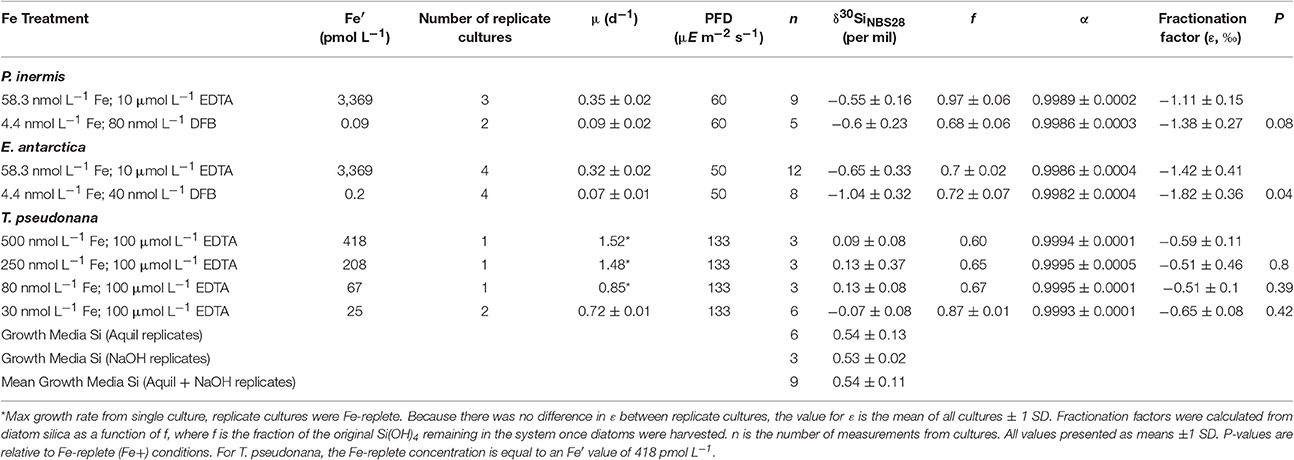- 1Research School of Earth Sciences, Australian National University, Canberra, ACT, Australia
- 2Ecochemistry Laboratory, Institute for Applied Ecology, University of Canberra, Canberra, ACT, Australia
by Meyerink, S., Ellwood, M. J., Maher, W. A., and Strzepek, R. (2017). Front. Mar. Sci. 4:217. doi: 10.3389/fmars.2017.00217
In the original article, there was a mistake in Table 1 as published. It seems that during the transcription of the data into Table 1 an error occurred whereby three values from a different experiment were inadvertently added to the average silicon isotope data for iron-limited Eucampia antarctica experiment (Eucampia antarctica 4.4 nmol L−1 Fe; 40 nmol L−1 DFB). The corrected Table 1 appears below. Note that the dataset used to generate Figure 2 was not in error. The authors apologize for this error and state that this does not change the scientific conclusions of the article in any way.

Table 1. Culture conditions, growth rates, Fe concentrations and Results from the Si isotope fractionation experiments for Proboscia inermis, Eucampia Antarctica, and Thalassiosira pseudonana.
In the original article, the error in Table 1 was translated through to a silicon isotope value quoted in the Abstract and the Results section of this manuscript. In the Abstract and in the Results section titled “Effects of Fe-Availability on Si Isotope Fractionation” the value of −1.57 ± 0.50‰ (n = 11) is in error as result of the error in Table 1. The correct value should be −1.82 ± 0.36‰ (n = 8).
A correction has been made to the Abstract and the following paragraph in the Results section titled “Effects of Fe-Availability on Si Isotope Fractionation”:
Abstract: The fractionation of silicon (Si) isotopes was measured in two Southern Ocean diatoms (Proboscia inermis and Eucampia antarctica) and a coastal diatom (Thalassiosira pseudonana) that were grown under varying iron (Fe) concentrations. Varying Fe concentrations had no effect on the Si isotope enrichment factor (ε) in T. pseudonana, whilst E. antarctica and P. inermis exhibited significant variations in the value of ε between Fe-replete and Fe-limited conditions. Mean ε values in P. inermis and E. antarctica decreased from (± 1 SD) −1.11 ± 0.15‰ and −1.42 ± 0.41‰ (respectively) under Fe-replete conditions, to −1.38 ± 0.27‰ and −1.82 ± 0.36‰ (respectively) under Fe-limiting conditions. These variations likely arise from adaptations in diatoms arising from the nutrient status of their environment. T. pseudonana is a coastal clone typically accustomed to low Si but high Fe conditions whereas E. antarctica and P. inermis are typically accustomed to High Si, High nitrate low Fe conditions. Growth induced variations in silicic acid (Si(OH)4) uptake arising from Fe-limitation is the likely mechanism leading to Si-isotope variability in E. antarctica and P. inermis. The multiplicative effects of species diversity and resource limitation (e.g., Fe) on Si-isotope fractionation in diatoms can potentially alter the Si-isotope composition of diatom opal in diatomaceous sediments and sea surface Si(OH)4. This work highlights the need for further in vitro studies into intracellular mechanisms involved in Si(OH)4 uptake, and the associated pathways for Si-isotope fractionation in diatoms.
Effects of Fe-Availability on Si Isotope Fractionation: Mean values for ε varied between the Fe-replete and Fe-limited conditions for the two Southern Ocean diatoms (Table 2). While there was some variability in the values of ε for E. antarctica, there was a significant difference in ε (p = 0.04) between Fe-replete and Fe-limited conditions, with mean ε values being more negative for Fe-limited cultures (Fe-limited, ε = −1.82 ± 0.36‰; Fe-replete, ε = −1.40 ± 0.41‰) (Table 1). Mean ε values were also more negative for P. inermis cultured under Fe-limited conditions (Fe-limited, ε = −1.38 ± 0.27‰; Fe-replete, ε = −1.11 ± 0.15‰). Both Fe-replete and Fe-limited datasets for P. inermis exhibited a significant difference at the 90% confidence interval (p = 0.08), and removing outliers from both Fe-replete and Fe-limited data sets for P. inermis makes the difference more significant (p = 0.04).
The authors apologize for this error and state that this does not change the scientific conclusions of the article in any way.
Conflict of Interest Statement
The authors declare that the research was conducted in the absence of any commercial or financial relationships that could be construed as a potential conflict of interest.
Keywords: silicon isotopes, Southern Ocean, diatom, isotope fractionation, iron
Citation: Meyerink S, Ellwood MJ, Maher WA and Strzepek R (2017) Corrigendum: Iron Availability Influences Silicon Isotope Fractionation in Two Southern Ocean Diatoms (Proboscia inermis and Eucampia antarctica) and a Coastal Diatom (Thalassiosira pseudonana). Front. Mar. Sci. 4:280. doi: 10.3389/fmars.2017.00280
Received: 16 August 2017; Accepted: 17 August 2017;
Published: 30 August 2017.
Edited and reviewed by: Brivaela Moriceau, Centre National de la Recherche Scientifique (CNRS), France
Copyright © 2017 Meyerink, Ellwood, Maher and Strzepek. This is an open-access article distributed under the terms of the Creative Commons Attribution License (CC BY). The use, distribution or reproduction in other forums is permitted, provided the original author(s) or licensor are credited and that the original publication in this journal is cited, in accordance with accepted academic practice. No use, distribution or reproduction is permitted which does not comply with these terms.
*Correspondence: Scott Meyerink, c2NvdHQubWV5ZXJpbmtAYW51LmVkdS5hdQ==
Michael J. Ellwood, bWljaGFlbC5lbGx3b29kQGFudS5lZHUuYXU=
 Scott Meyerink
Scott Meyerink Michael J. Ellwood
Michael J. Ellwood William A. Maher
William A. Maher Robert Strzepek1
Robert Strzepek1